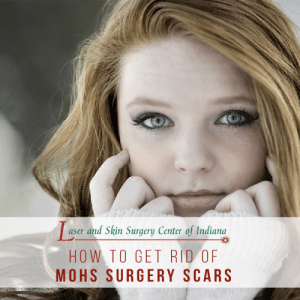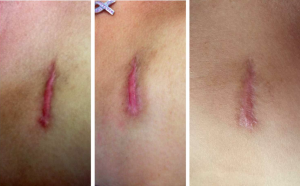Mohs Surgery Recovery

Mohs Surgery Recovery: Minimizing the Appearance of Scars After Surgery
When you are recovering from a skin cancer treatment and have received the relieving news that your cancer is gone, you may focus on the scars commonly visible after surgery. This is particularly true for patients who had cancer removed from the facial area. Fortunately, there are things you can do to reduce the visibility surgical scars. After your Mohs surgery recovery, our skin care team can help you diminish the appearance of scars with different treatments, including our new Microneedling treatment and our tried and true laser skin resurfacing device.
What is Mohs Surgery?
Mohs surgery is specifically designed for the treatment of skin cancer. The treatment was developed in the 1930s by Dr. Frederick Mohs, and has become increasingly popular in the past decade. Mohs surgery is the single most effective method for removing the two most common forms of skin cancer: basal cell carcinoma and squamous cell carcinoma. Mohs surgery has the ability to remove nearly all cancer cells, while maintaining the integrity of the surrounding healthy tissue. Cure rates with this type of surgery are very high, at 98 percent or greater.
Actor Hugh Jackman Talks Skin Cancer and Mohs Surgery
How Does Mohs Surgery Differ From More Traditional Surgical Techniques?
Mohs micrographic surgery differs from traditional excisional surgery because it is performed all at one site. A dermatologic surgeon trained in Mohs micrographic surgery gives you a local anesthetic before removing a thin layer of skin from the affected area. The skin is then examined microscopically by the Mohs surgeon using frozen sections at the on-site lab. If cancer cells still remain, you are called back into the operating room and another thin layer is removed. The process is repeated until the edges of the final tissue sample are cancer-free. At this point, the dermatologist will suture the wound. In some cases, a skin graft may be necessary.
Laser Skin Resurfacing: Laser Away Scars and Regrow Healthy Skin Tissue
Laser skin resurfacing is performed using an ablative laser. Ablative lasers vaporize the skin on the surface of the body and are an effective method for removing the topmost layer, leaving room for healthy new skin to grow. The CO2 laser can be focused to a very thin beam for scalpel-thin cuts. It can also be used in a more diffused mode to vaporize a greater amount of soft tissue. This process is commonly used to treat a wide variety of skin conditions, including acne scars, extensive sun damage and surgical scars.
The process can take anywhere from a couple minutes to an hour depending on the size of the area to be treated. Because of the ablative nature of the procedure, an anesthetic or numbing agent will be required. The laser skin resurfacing technique stimulates the production of new collagen in the skin to complete the healing process. This is useful in Mohs surgery recovery, reducing the appearance of residual surgical scars once the cancer has been completely removed.
Microneedling: How This Celebrity Beauty Craze Helps Mohs Surgery Recovery
Microneedling, or collagen induction therapy and percutaneous induction, is a minimally invasive procedure and effective skin rejuvenator that helps stimulate the production of healing collagen. The procedure uses a device containing many fine needles that are applied across the skin to create a controlled micro-injury. This injury triggers the body to produce collagen and elastin. The result of microneedling is improved skin texture and increased firmness. Microneedling is also an effective treatment for scars and stretch marks, and the depth of the treatment can be controlled by your provider to ensure the best results.
Before treatment, you will receive a topical anesthetic cream on your face. You will hardly feel anything when your skin care specialist applies the microneedling device. Multiple treatments are often required to achieve the desired final result. You may also benefit from maintenance treatments every six to 12 months. Because it can be performed on all skin types and colors, microneedling is occasionally preferred over laser treatments that can cause pigmentation issues in some darker skin tones.
Microneedling requires no downtime following the first treatment. Initial redness may occur, but this usually dissipates by the next day. For Mohs surgery recovery scars, however, you should expect to receive more than one treatment. Repeat treatments are spaced four to six weeks apart to give your body a chance to rebuild healthy skin cells.
Start Your Scar Treatments to Help With Mohs Surgery Recovery in Indianapolis
Dr. C.William Hanke is an expert in Mohs surgery, skin cancer treatments and scar revision. As a board-certified dermatologic surgeon and past president of the American College of Mohs Surgery, Dr. Hanke has contributed research and innovation to the field of Mohs micrographic surgery. Furthermore, Dr. Hanke’s skill as a general and cosmetic dermatologist provides patients with advanced skin care through lasers and other technologies to reduce the appearance of scars.
Schedule a consultation today with Dr. Hanke and our team of skin care experts and find out which treatments for scar reduction are right for you.


